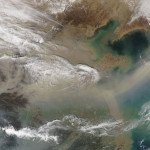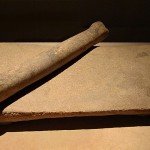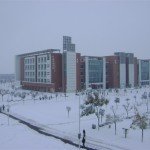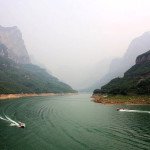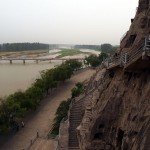Henan Province
Background
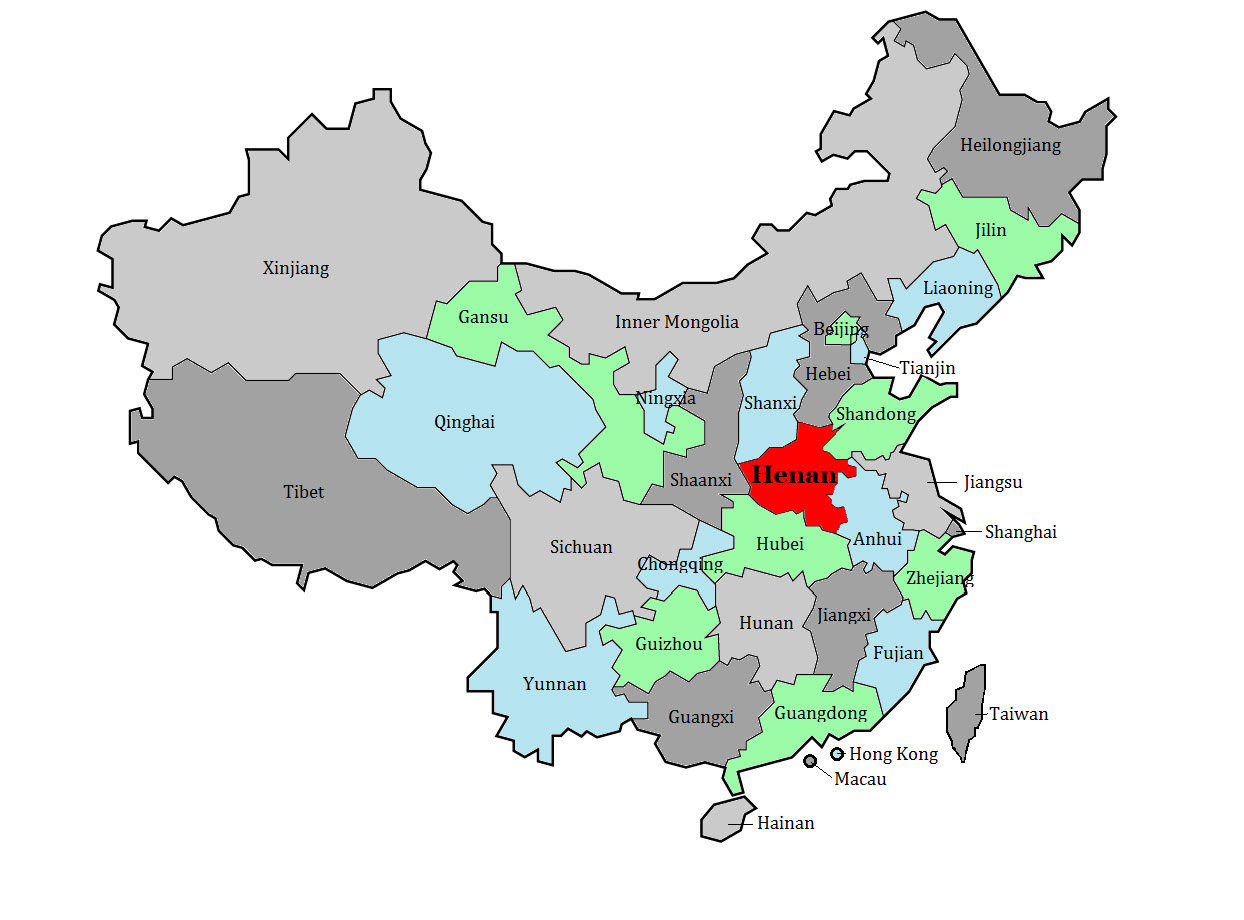 Stretching some 480 km from north to south and 560 km east to west at its widest point, Henan spreads across sizable part of the North China Plain. Henan is bordered by Shanxi and Hebei to the north, Shandong and Anhui to the east, Shaanxi to the west and Hubei to the south. The Yellow River cuts through the northern tip of the province with about five-sixth of its land falling south of the river. Henan’s name in fact means “South of the River”. At an area of 167,000 square kilometers, Henan is slightly larger than Tunisia.
Stretching some 480 km from north to south and 560 km east to west at its widest point, Henan spreads across sizable part of the North China Plain. Henan is bordered by Shanxi and Hebei to the north, Shandong and Anhui to the east, Shaanxi to the west and Hubei to the south. The Yellow River cuts through the northern tip of the province with about five-sixth of its land falling south of the river. Henan’s name in fact means “South of the River”. At an area of 167,000 square kilometers, Henan is slightly larger than Tunisia.
Man has been living in Henan since prehistoric times. Archaeological digs within Henan have found artifacts from early Yangshao and Longshan cultures. These early peoples farmers as well as hunters and fishers with domesticated dogs and pigs. China’s first dynasty, the Xia Dynasty, (2200-1600 BCE) ruled in large parts of what is modern day Henan. The Xia fell to the Shang Dynasty (1600-1046BCE). Archaeological evidence suggests that the early Shang Dynasty was quick to develop a political hierarchy and a complex economic and social system.
Shang cities, for instance, were large and protected by massive walls up to 40 m wide and 10 m high, the largest of which are estimated to have required an investment of some 13 million labor days. “Oracle bones” – chicken bones and turtle shells – dating from the Shang time, record the first examples of Chinese character writing. These bones were used by rulers to consult ancestral spirits. Some of the most important Shang Dynasty cities were located by modern Shangqiu, Yanshi, Anyang and Zhengzhou.
By 770, Zhou political supremacy was waning. Although still deemed ruler of China, Zhou dynastic authority was challenged during the Spring and Autumn Period (770-453 BCE). Henan and large parts of China fragmented into small independent states, constantly fighting for control of land and resources. It was during this time that philosophers such as Confucius, the Art of War author Sun Tzu, and eventually Daoism founder Laozi began developing ideas on ways to bring an end to the constant warfare.
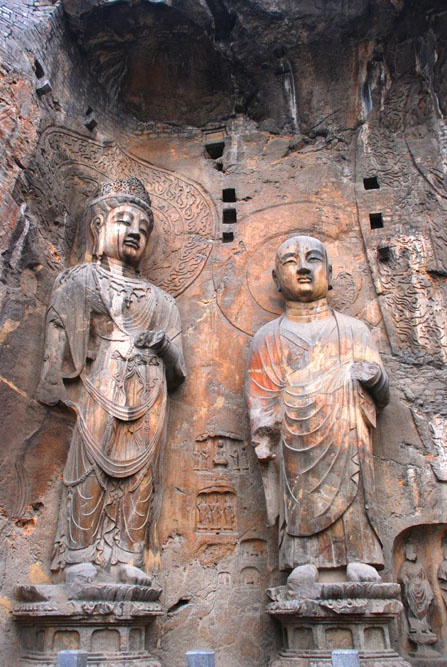
The Stone Sculpture of the Buddhist Monks
During the Warring States Period (453-221 BCE) that followed, these smaller states consolidated into seven larger states. Henan itself was ruled by the kingdoms of Wei, Chu and Han. It took until the founding of the Qin Dynasty (221-206 BCE) for China and Henan to be united again under one political ruler. The Qin quite quickly gave way to the Han Dynasty (206 BCE-220 CE).The Shang fell to the Zhou Dynasty (1046-221 BCE). The Zhou worshipped Heaven, a benevolent force that helps right triumph in human matters. The Zhou conquerors argued that the last Shang kings were corrupt and irresponsible and that Heaven therefore granted the Zhou the right to rule in their place. Thus was created the Chinese ideal of the “Mandate of Heaven”, where Heaven bestows on an honorable and noble leader the right to rule. This idea of Mandate of Heaven kept only by good governance remained a key political belief throughout the rest of the Chinese dynastic era.
Like many provinces in this northern part of China, Henan saw its political control shift between the Han Chinese and many of the nomadic tribes of the north over the centuries following the end of Han Dynastic control. Its fertile fields were a large prize well worth the fight. During this time, the capital of China shifted between Henan’s Luoyang and Shaanxi’s Chang’an. The Sui Dynasty (589-618) succeeded in reasserting firm Chinese control over the area. During the Tang Dynasty (618-907) that followed Henan became one of wealthiest places in the empire. When the Tang Dynasty eventually shattered due to internal corruption and power jockeying, the Period of Five Dynasties and Ten Kingdoms (907-960) saw Kaifeng in eastern Henan rise as the capital of four of these five dynasties.
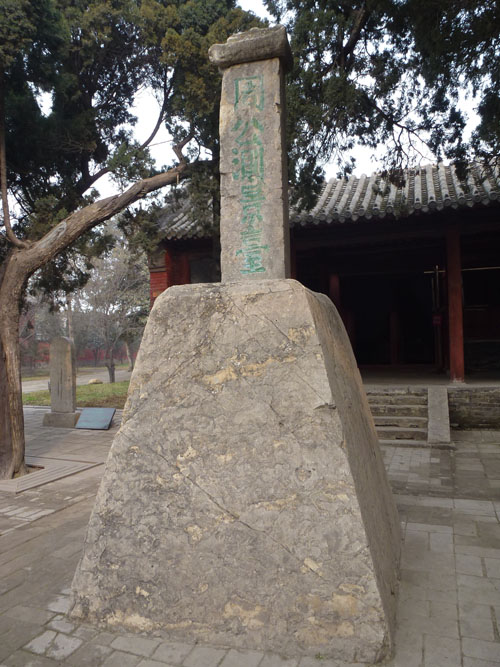
Tang Astronomical Instrument – Casts no shadow on Summer Soltice
The Northern Song Dynasty (960-1127) kept its capital at Kaifeng and it grew for a period to be the largest city in China and the world. By 1127, however, the Song were being attacked by the northern nomadic Jurchen people. By 1142, the Song imperial court escaped south, relinquishing all of northern China including Henan. The Southern Song Dynasty (1127-1279) accordingly shifted the Chinese Imperial Capital to Hangzhou while the Jurchens made Kaifeng their southern capital. Kaifeng grew in importance in 1214 when pressure from the Mongol people caused the Jurchens to shift their main capital southwards. In 1234, the Jurchens fell to the Mongols who eventually conquered all of China founding the Yuan Dynasty (1279-1368). The Yuan Court oversaw the creation of Henan’s modern borders which remained little changed over subsequent dynasties.
The Qing Dynasty was overthrown by the Republic of China in 1911 launching the start of China’s modern era. Railways were constructed within the province spurring economic growth and raising the profile of cities that were previously small provincial backwaters. The development of the Pinghan and Longhai railway lines, for instance, turned Zhengzhou into an important transportation hub. Economic progress in Henan was again hurt when a three-year drought was followed by the 1931 Yellow River Flood which saw the eventual death of an estimated 3-4,000,000 people, many of whom were Henan residents.
stele is so arranged that the sun at noon on the summer solstice casts no shadow beyond its heavy truncated pyramidal base.
During the Qing Dynasty (1644-1911) Henan was struck by a series of natural disasters that significantly weakened its economy and depleted its population. In 1876-1879, for instance, a protracted drought caused a serious famine in northern China resulting in the death of an estimated 9 million people died in the provinces of Henan, Shandong, Shaanxi, Hebei and Shanxi. In 1887, an aberrant Yellow River flood in what was otherwise a period of drought saw approximately 130,000 km² inundated and 900,000 people die. The Yellow River dikes broke near Henan’s city of Zhengzhou.
In 1937, the Japanese invaded China. In order to stop the Japanese armies advanced, in 1938 Chiang Kai-shek ordered that the Yellow River dikes be broken. The resulting flood – for which the Chinese civilian population was wholly unprepared – was one of the largest acts of environmental warfare in history. The flooding and resulting famine caused over 1 million deaths in Henan, Anhui and Jiangsu while doing little to slow down the Japanese invasion.
In 1949, the People’s Republic of China was founded. In 1954, the communists moved the capital of Henan to Zhengzhou. In 1958, Henan became the heart of Mao Zedong’s collectivization movement. The idea was to group people in communes in order to increase agricultural output, thus freeing peasants to produce steel so the People’s Republic’s steel production could make a Great Leap Forward to overtake that of Britain’s. The idea of creating communes became official state policy in 1958 after Mao Zedong visited an unofficial commune in Henan.
Agricultural mismanagement resulted. Farmers abandoned crops to make what was to prove worthless backyard steel. Crops were planted too close together to grow properly. Crops were not properly harvested. An estimated 30-40 million people died during the subsequent famines. Henan was one of the hardest hit of all China’s provinces and millions of Henan residents lost their lives during this period of social and economic experimentation.
By the 1990s, as China’s economic development slowly spread inland, Henan finally began to profit from the 1978 market opening launched by Deng Xiaoping. During the same period, poor Henan residents began selling blood for money. Due to the reuse of needles, this practice caused the spread of the HIV virus to an estimated 10,000-100,000 Henan peasants. Many of these were subsequently grouped into “AIDs villages” where most of the residents are HIV-positive. These villages were initially hidden by local officials until exposed nationally.
People
In 2018, Henan’s population stood at approximately 96 million people, making it China’s 3rd most populous region. Almost 99% of these are ethnic Han. The Hui or Chinese Muslims are the largest minority group in the province. Some Manchu and Mongol peoples also exist in small pockets in some rural areas. Most Henan residents live in rural communities. Recently, however, the rate of rural-to-urban migration is increasing as Henan’s economy continues to develop. Zhengzhou, for instance, has an urban population exceeding 2.5 million. Luoyang has approximately 1 million residents.
Henan suffers from one of the most unbalanced gender ratios in China. China’s traditional preference for sons, particularly in rural areas, led many Henan residents to engage in selective abortion and sometimes infanticide. As a result of this practice, by 2000 Henan had a gender ration of approximately 118 males to 100 females. Aborting female fetuses in Henan is now illegal. Families with girls are also given a supplementary allowance by the Henan provincial government.
Economics
According to China’s National Bureau of Statistics, in 2018 Henan’s GDP was approximately $699 billion, the 5th largest in the country. Its per capita GDP was approximately $7,729. Overall, its GDP accounts for 5.3% of China’s total which was generated by 6.9% of China’s population. Its GDP per capita is ranked 19th out of China’s 33 provinces, municipalities, and autonomous regions. Henan’s primary industries accounted for approximately 9.6% of GDP, secondary industries 47.7% of GDP and tertiary industries 42.7% GDP.
Since the 1990s, Henan’s economy has expanded rapidly. Agriculture continues to be an important economic driver; indeed, Henan is considered one of the breadbaskets of China. Main food crops include winter wheat, millet, kaoliang, soybeans, barley, corn, sweet potatoes, peanuts, mushrooms, rice, green lentils, cotton and tobacco. Henan is China’s largest wheat producer and one of China’s largest cotton and tobacco producers. The province is also a significant manufacturer of vegetable oil especially sesame oil. Fruit farming has expanded considerably in recent years and Henan now harvests large crops of dates, persimmons, apples, pears, walnuts, and chestnuts. Henan also raises yellow oxen, beef, donkeys, hogs, goat, sheep, and chickens.
Silk is also a significant mainstay. Indeed, Henan’s silkworm raising industry dates from the Han Dynasty. Similarly, Henan’s large farming business has driven the development of its food processing industry. Henan specializes in the production of meat, frozen food, seasoning, instant noodles, biscuits and other processed foods. Likewise, Henan’s cotton-growing region supplies a large textile industry.
Henan is rich in mineral resources including molybdenum, marble trona, iron ore, asbestos, aluminum, natural gas, cesium, pyrite, bauxite, mica, coal, perlite, lead, gold, silver and refractory clay. Henan’s Zhongyuan Oilfield and Pingdingshan Coal Mine are some of China’s largest, and Henan produces almost half of the China’s aluminum oxide.
Henan’s industrial development has been based around its mineral resources. Important industrial industries include the manufacture of non-metallic mineral products, the mining and washing of coal, the manufacture and processing of ferrous and non-ferrous metals, the production of chemical raw materials and products and computer, communication and electronic equipment manufacturing. Henan is also an important manufacturer of tractors, agricultural equipment and automobiles.
Henan’s service sector is centered around the finance and service businesses which are concentrated in its larger cities such as Zhengzhou and Luoyang. Henan’ tourism industry is also thriving and is an important economic generator. As the birthplace of Han people, the province many historical and cultural sites.
In 2017, foreign direct investment in the province exceeded $17 billion. Hong Kong is the largest investor in the province, followed by the United States, the United Kingdom and Taiwan.
Lay of the Land
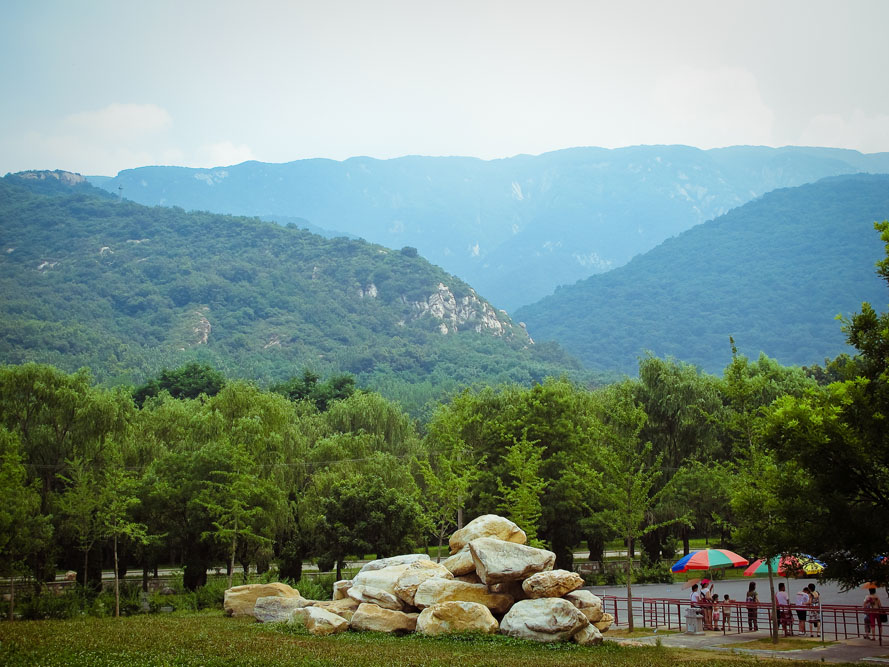
Shaolin Temple in Dengfeng
Henan’s topography is mountainous in the west flattening to plains in the east. The northeast-to-southwest trending Taihang and Zhongtiao mountains chase along the Shanxi-Henan border, marking the eastern point of the Loess Plateau. Below the Yellow River, the western Xionger and Funiu Mountains stretch northwest to southeast. These mountains are the eastern expansion of the Qin Mountain axis. These mountains, along with the Huai River, are considered geological, geographical and cultural division between North and South China. Henan’s Tongbai and Dabie ranges extend southward from this same axis eventually running along the Henan-Hubei border. These two ranges are demarcated by a 120 to 160-kilometer valley cut by the Tang and Bai rivers. This valley allows easy passage from Henan to western and southern China. Historically, it has been an important trade and migration route.
Most of Henan’s east spills out onto the great North China Plain. Over millennia, this plain was formed by the disposition of silt carried from the Loess Plateau by rivers and wind. Henan major rivers include the Yellow River, the Huai River, the Tang River and the Bai River, the latter two draining southward until they merge with the Han River, itself a major tributary of the Yangtze.
Henan’s portion of the Yellow River starts when it turns eastward close to the Shanxi-Shaanxi-Henan corner. It then flows across Henan’s northern tip travelling first through the Sanmen Gorge before spilling out on to Henan’s plain. On the plain, the Yellow River’s flow slows substantially meaning that it is no longer able to carry its silt. Historically, this deposited sedimentation caused natural subaqueous dams to build which were often undetectable. Eventually, these hidden dams caused the river to surge from its bed out across the flatland.
To prevent flooding, the Chinese constructed levees along the river’s banks. Over time, the levees needed to be raised as depositing sediment pushed the river upward. When the levees did burst, the levees made the floods more severe as the flood water was unable to recede back into the riverbed because the bed was now elevated over the surrounding countryside. The deadliest of these Yellow River floods was in 1332-33 when an estimated 7 million people died. Since 1949, the construction of dams coupled with high upstream water usage have all but ended the floods that have plagued Henan for millennia.
Henan’s Huai River begins in its Tongbai Mountains before flowing through southern Henan onward into Anhui and Jiangsu before entering the Yangtze. In 1975, many of the early dams constructed by the communists on the Huai River in central and southern Henan were unable to sustain the pressure caused by the extraordinarily high levels of rainfall dropped by Typhoon Nina. 62 of these dams eventually failed. Estimates of life loss due to the ensuing flooding, famine and disease ranged between 85,000- 230,000.
Interesting Aspects for a Traveler

Long men Grottoes
During the 1937-1935 Second Sino-Japanese War, the Japanese heavily bombed Henan’s capital, Zhengzhou all but eradicating its historical sites. For travelers, the city is best used as a transportation hub. That said, its Henan Provincial Museum has an excellent collections ranging from Shang Dynasty bronzes and oracle bones to Qing Dynasty porcelain.
Nanjiecun, south of Zhengzhou, is one of China’s last remaining collectives. Visiting gives the traveler a sense of what it might have been like to live in China during the 1950s-1970s. Painted communist slogans on dormitories encourage workers. At the commune’s Red Square sentinels guard statues of Mao Zedong while portraits of Stalin, Lenin, Engels and Marx are all proudly displayed. Schools, factories and government buildings all share qualities of the same austere socialist architecture.
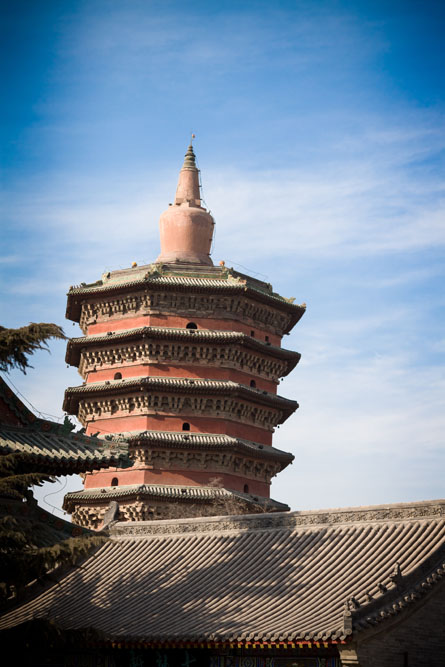
1000 year old Pagoda in Anyang City
Henan’s city of Luoyang was the capital of 13 different dynasties. Its Old Town offers a maze of narrow alleys and roads to explore, many lined with traditional Chinese courtyard houses. Its antique market and its Drum Tower dating from 1555 are both well worth the visit. The Luoyang Museum has a very good collection of Tang Dynasty porcelain as well as pottery, bronzes and other artifacts from the many Dynasties that made Luoyang their capital. The museum also houses a wonderful collection of Mao Zedong memorabilia.
Wangcheng Park is home to the city’s annual peony festival. Wengchang Square is great for people viewing; locals gather here to play games, chat and stroll. Luoyang’s Eastern Zhou Royal Horse and Carriage Museum showcases the remains of horses buried alive at the time of the emperor’s passing.
Close to Luoyang reside the famous Longmen Caves. A UNESCO world heritage site, the caves house some of the best examples of Chinese Buddhist rock carvings. During a roughly 200 year period between 494-694 CE, over 100,000 images of Buddha and his disciples were carved into an almost kilometer long cliff. Many of the statues were damaged during the Cultural Revolution, were chiseled off to be sold abroad, or were worn away by weather. That said it remains a masterpiece of Buddhist art. The nearby White Horse Temple is an active monastery considered to be the first Buddhist Temple built in China. Although now largely restored, it was originally built during the first century of the Common Era.
Over the years Kaifeng has been ravaged frequently by Yellow River flooding. It is estimated that between 1194 and 1938, the city was flooded 368 times. Much of what was once the old Song capital is now believed to be buried under sediment estimated to be over 8 meters deep. Nevertheless, Kaifeng’s Old Town, within Qing-era city walls still retains much of its historic charm. Its Temple of Chief Minister once housed over 10,000 monks on 34 acres. It was originally constructed in 555, rebuilt in 1640 and then subsequently restored. The temple is best known for the Four-Faced, Thousand Hand, Thousand Eye Guanyin statue which stands 7 meters tall and took 58 years to carve.
Equally worth a visit is the Qing-era Shanshangan Guild Hall. It now houses an exhibition on historic Kaifeng. Kaifeng Fu recreates Song Imperial life by replicating period buildings such as the armory, a vinegar workshop and a pagoda. Kaifeng Riverside Scenic Park and Qingming Garden and Longting Park are also both worth visits. Qingming is a theme park recreating Zaduan’s famous Qingming Painting. Longting Park is lake dappled and lovely.
The isolated and thus well-preserved village of Guoliangcun, located high in the Wanxian Mountains, is a beautiful traditional Chinese stone village which became famous after it was used for the setting of several Chinese films. It is now frequented by artists. Everything in the village is made from the same mountain stone including its narrow roads, houses and bridges.
Zhuxian Zhen is known for its 1000 year old craft of woodblock printing still practiced in the traditional manner by several families in the village. Traditionally the prints are adhered to the doors and walls of houses to bring good luck at New Year. Chinese folk characters, gods and other luck-bringing characters are frequently represented in the carvings.
Dengfeng is the starting point to explore Mount Song – considered one of the sacred mountains of Chinese Daoism. It is also close to the Shaolin Zen Buddhist Temple. Originally founded around 500 AD, the Temple was destroyed by fire in 1928. Shaolin Temple is reknown for being the home of Kung Fu, the martial art system purportedly created in order to help keep the monks fit.
Excellent hikes lead off from the Temple; many more hikes can also be accessed in the surrounding area, some with lovely temples or pagodas resting along their paths or at their peaks. Also not to be missed is the 484 AD Songyang Academy, one of China’s oldest Academies which houses two cypress believed to be over 4000 years old, and the Zhongyue Temple, an active Daoist Monastery dating to the second century BC.

